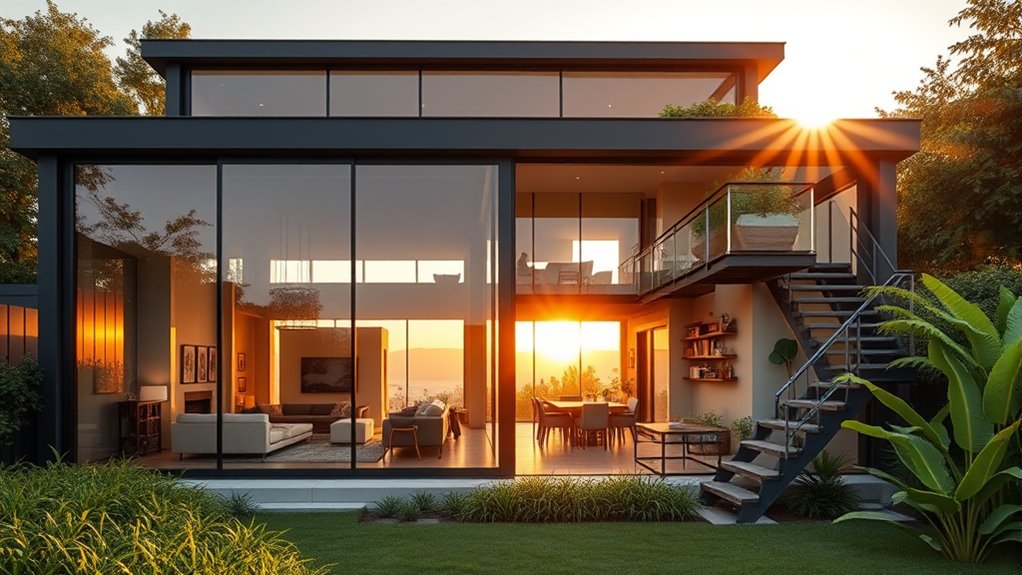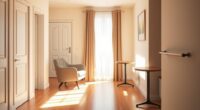To design a home that grows with you, focus on creating flexible layouts with open plans, multi-purpose rooms, and movable partitions. Incorporate adaptable storage, modular furniture, and outdoor spaces that can evolve over time. Think ahead about future expansions like additional bedrooms or multipurpose zones. By planning with versatility in mind, you’ll guarantee your home adapts seamlessly to changing needs. Keep exploring, and you’ll discover how to turn these ideas into your perfect adaptable space.
Key Takeaways
- Incorporate open floor plans and flexible furniture to easily reconfigure spaces as needs evolve.
- Use modular storage and movable partitions to adapt rooms for different functions over time.
- Design multi-purpose areas like bonus rooms for future use as bedrooms, offices, or playrooms.
- Plan for future expansion with adjustable walls or modular components to accommodate growing families.
- Select durable, low-maintenance outdoor features that can be modified or expanded for outdoor living needs.
Embracing Flexibility in Your Home’s Layout
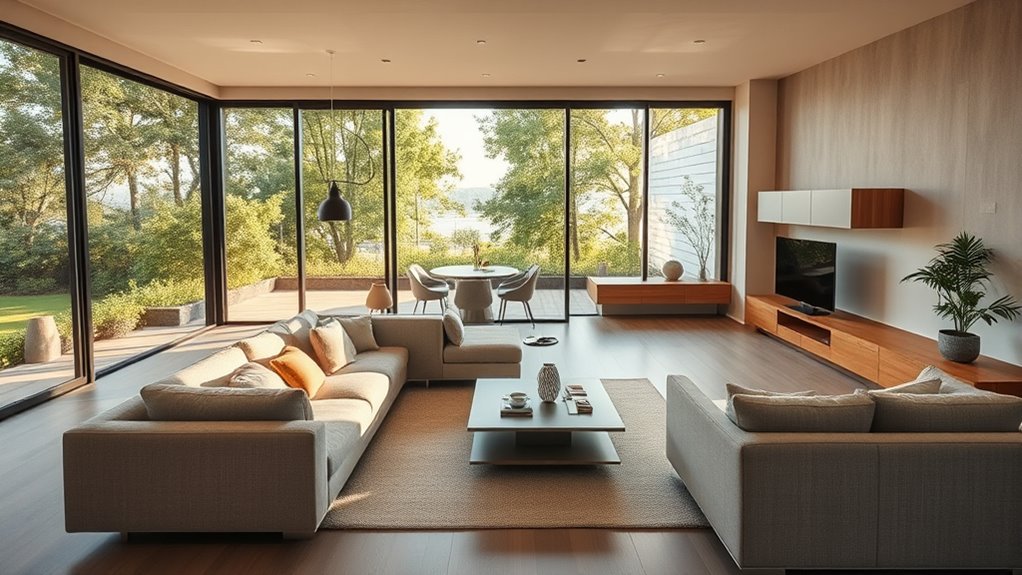
To create a home that adapts to your changing needs, embracing flexibility in your layout is essential. Flexible home layouts feature multi-purpose rooms that can serve as play areas, guest bedrooms, or offices, making your space versatile. Incorporating natural materials can add warmth and authenticity to adaptable spaces while maintaining a cozy farmhouse aesthetic. An open floor plan enhances adaptability by allowing you to reconfigure areas easily without major renovations, supporting future modifications. Inserting movable partitions or modular furniture allows you to adjust room sizes and functions over time. Prioritizing core infrastructure—such as electrical and plumbing systems—ensures seamless expansion or conversion later. Additionally, considering home growth during initial design, like extra bedrooms or flexible common areas, helps your space evolve with your family’s needs, creating a home that truly grows with you. Understanding flexible layouts and their benefits can significantly improve your home’s ability to meet evolving lifestyle demands, especially when planning for future modifications. Incorporating innovative storage solutions can further maximize space utilization and adaptability.
Incorporating Adaptable and Multi-Functional Spaces
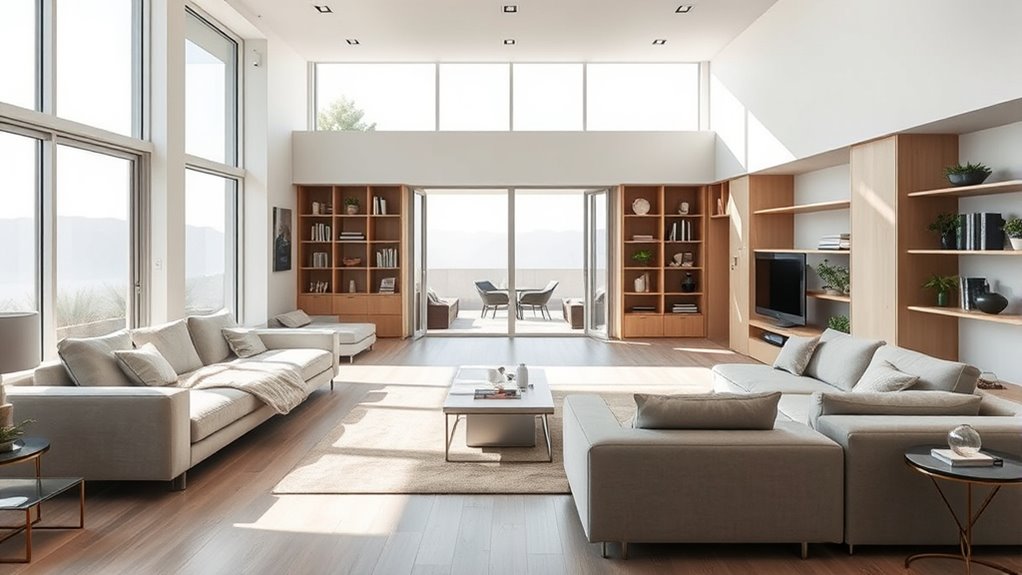
You can create spaces that serve multiple purposes, like a bonus room that works as a play area, office, or guest bedroom. Flexible layouts with open plans make it easy to reconfigure rooms as your needs change. Using movable partitions or convertible furniture helps maximize space and adapt quickly to your evolving lifestyle. Incorporating multi-functional furniture can further enhance the versatility of your space, allowing for seamless transitions between different uses. Additionally, investing in adaptable storage solutions ensures your space remains organized and functional as your needs grow and shift over time. Embracing attention during the design process can lead to more thoughtful and innovative solutions that truly accommodate your lifestyle.
Flexible Room Designs
Flexible room designs leverage open layouts and multi-purpose furnishings to adapt to your evolving needs, making your home more functional over time. You can create flexible rooms that serve multiple functions, such as a guest bedroom transforming into an office or play area. Incorporating convertible furniture like fold-away beds and movable partitions allows you to switch functions effortlessly. Planning for future expansion with adjustable walls or modular components ensures your space remains adaptable as your family grows. Multi-functional spaces can include zones for work, entertainment, and relaxation within the same area, reducing clutter and optimizing space. This adaptable design minimizes costly renovations later, letting your home evolve seamlessly. Incorporating multi-purpose furnishings and flexible elements enhances your home’s adaptability and long-term usability. Additionally, considering support hours and park schedules can help you plan your home projects during optimal times to avoid disruptions. Using decluttering strategies can further maximize your available space and maintain an organized environment. Here are ideas to inspire your flexible room setup:
| Idea | Function | Features |
|---|---|---|
| Guest Room | Bedroom/Office | Convertible furniture |
| Play Area | Kids’ play/Study | Movable partitions |
| Living Room | Lounge/Workspace | Open layout |
| Extra Room | Storage/Exercise | Modular walls |
| Flex Space | Media/Relaxation | Multi-zone design |
Multi-Purpose Room Ideas
Multi-purpose rooms maximize space by seamlessly shifting between functions like play areas, home offices, guest bedrooms, or craft rooms. To achieve this, incorporate a multi-functional room with flexible furniture such as fold-away beds, Murphy desks, or modular pieces. These elements enhance space efficiency and allow the room to adapt effortlessly to evolving needs. Using versatile furniture can further improve adaptability and functionality in your space. These pieces can be easily reconfigured or stored away when not in use, maintaining a clean and organized environment. Thoughtful zoning and versatile furniture arrangements keep the space organized, ensuring it remains clutter-free regardless of its current use. Incorporating multi-functionality into your design encourages creativity and maximizes the utility of every square foot. Use neutral colors and adaptable decor so the room stays stylish and versatile over time. Incorporating flexible design principles can help create a truly adaptable environment that responds to your lifestyle changes. Built-in storage solutions and designated zones help maintain order, making the space both functional and flexible. With these adaptable design strategies, your multi-purpose room becomes a dynamic space that grows with your lifestyle.
Future Space Adaptations
As your family’s needs change over time, designing your home with adaptable spaces guarantees it can evolve without costly renovations. Future space adaptations are key to this flexibility. Incorporate flexible rooms like bonus spaces that can become bedrooms, offices, or playrooms as needed. Use multi-purpose areas with movable furniture and adaptable layouts for seamless progressions. Planning for home expansion, such as adding bedrooms or extending living areas, assures your home grows with you. Built-in storage solutions and modular furniture maximize space efficiency and adaptability for evolving family belongings. Additionally, consider features for multi-generational living, like accessible bathrooms or first-floor master suites. Incorporating reclaimed wood and other natural elements can further enhance the sense of adaptability and harmony within your evolving living space. Being mindful of self watering plant pots can also contribute to sustainable and low-maintenance greenery, adding to the home’s versatility. Integrating multi-functional furniture solutions can further enhance the flexibility of your space. These thoughtful choices help create a home that remains functional, comfortable, and ready for whatever the future holds.
Planning Storage Solutions That Evolve Over Time
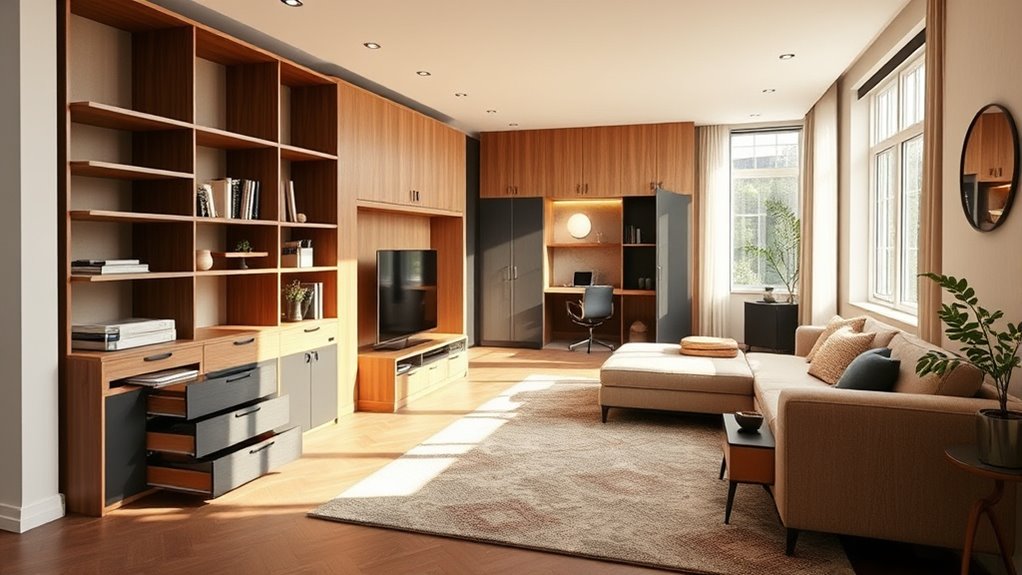
To guarantee your home adapts as your needs change, consider modular storage designs that can be easily reconfigured. Incorporate hidden compartments and vertical storage options to maximize space without clutter. Plan for future needs with flexible organization systems. Utilizing versatile storage solutions can further enhance the adaptability of your space. For example, adjustable shelving and multi-purpose furniture enable customization as your collection of esthetician magnifying lamps or other equipment grows. This approach keeps your storage solutions versatile and ready to grow with your family, while also respecting your privacy preferences through transparent privacy policies. Additionally, understanding odor indicators can help you identify when certain storage areas may need cleaning or maintenance to prevent unpleasant smells or health issues. Incorporating data-driven marketing strategies into your organization plans can also help you optimize space based on usage patterns.
Modular Storage Designs
Planning modular storage solutions from the start allows your home to adapt seamlessly as your needs change. With modular storage, you can create an expandable design that grows with your family. These systems feature customizable units like shelves, drawers, and cubbies, enabling flexible organization tailored to your lifestyle. Recognizing patterns in angel number soulmates can also inspire meaningful additions to your space that reflect your personal growth. You can easily reconfigure or relocate components, avoiding costly renovations. To maximize space efficiency, select stackable or mobile modules that fit different room sizes and functions. Additionally, considering building codes and zoning regulations during planning ensures your storage solutions remain compliant as your home evolves. Incorporating privacy and cookie policies can also help maintain a secure and user-friendly environment as your home and needs develop. Integrating flexible design principles allows your storage solutions to adapt more effortlessly over time, ensuring long-term usability.
Hidden and Vertical Storage
Have you considered how hidden and vertical storage solutions can make your home more adaptable over time? Hidden storage, like built-in cabinets and under-stair compartments, maximizes space while keeping your home looking neat.
Vertical storage strategies, such as tall shelving units and wall-mounted organizers, use wall height to free up floor space and boost organization. Designing adjustable shelving and modular storage systems allows you to reconfigure as your needs change, ensuring your home remains flexible.
Incorporating concealed compartments within furniture or walls reduces clutter and enhances functionality. Planning for increased storage from the start helps your home evolve effortlessly, accommodating a growing family or shifting belongings without sacrificing style or space efficiency.
Future-Ready Organization
Thinking ahead when designing your home’s storage guarantees it can adapt as your needs change. To create a future-ready organization, incorporate flexible storage solutions that grow with you. Use built-in storage like adjustable shelves, deep closets, and hidden compartments to maximize space and flexibility.
Opt for modular furniture and versatile cabinetry that can be reconfigured or expanded over time. Dedicate zones for seasonal items, such as attic or basement storage, to keep clutter manageable. Utilize vertical space with wall-mounted shelves and hanging storage, freeing up floor area for future needs.
Plan for potential additions like extra closets or storage rooms during initial design, ensuring your home remains adaptable and functional as your lifestyle evolves.
Designing Outdoor Areas for Future Growth and Use
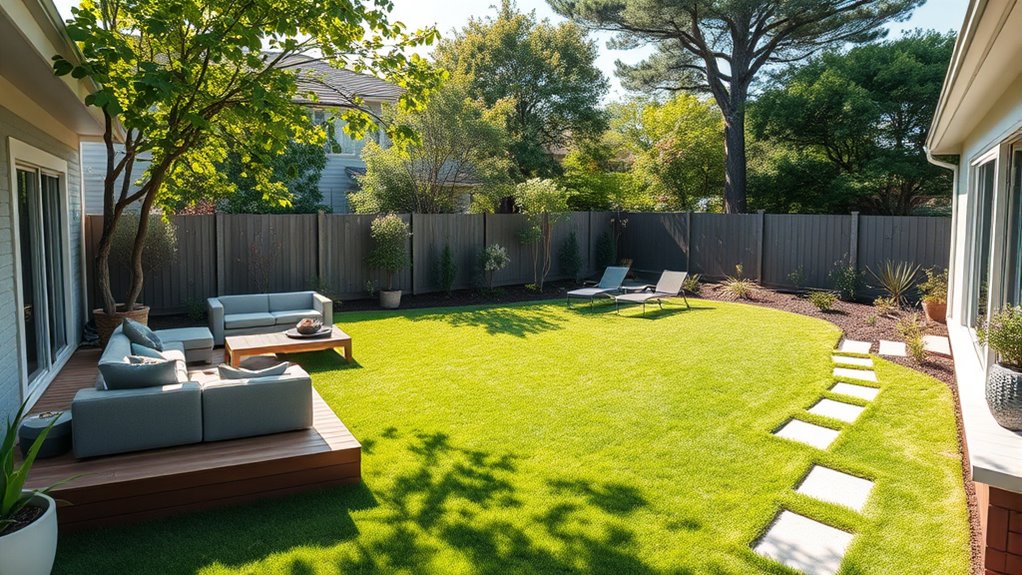
Designing outdoor areas that adapt to your family’s changing needs guarantees your yard remains functional and enjoyable for years to come. Focus on creating versatile zones, such as play areas, gardens, and entertainment spaces, that can evolve over time. Use durable, low-maintenance materials for outdoor furnishings and structures to withstand weather and reduce upkeep.
Plan for future additions like outdoor kitchens, fire pits, or shaded seating areas, so your outdoor space grows with your family. Incorporate a flexible design by including multi-purpose features like adjustable play equipment and modular furniture that can be reconfigured as interests shift.
Safety features, such as fencing and soft landing surfaces, ensure a secure environment for children’s outdoor activities, making your yard both adaptable and safe.
Collaborating With Experts to Future-Proof Your Home

Partnering with experienced builders is essential to guaranteeing your home can adapt to future needs. They bring expert guidance on incorporating structural features and flexible layouts that support seamless expansions.
Partnering with experienced builders ensures your home is flexible and ready for future needs.
These professionals help you plan for long-term durability while making modifications easier down the line. Consider their advice on code compliance and safety standards, which keep your home adaptable and compliant.
Collaborating with specialists allows you to customize solutions tailored to your family’s evolving needs, such as accessible spaces or multi-generational living areas.
Early consultations can also identify potential challenges and include cost-effective, future-proof features.
Ultimately, working with experts ensures your home remains adaptable, functional, and ready for whatever the future holds.
Personalizing Spaces for Your Family’s Changing Needs
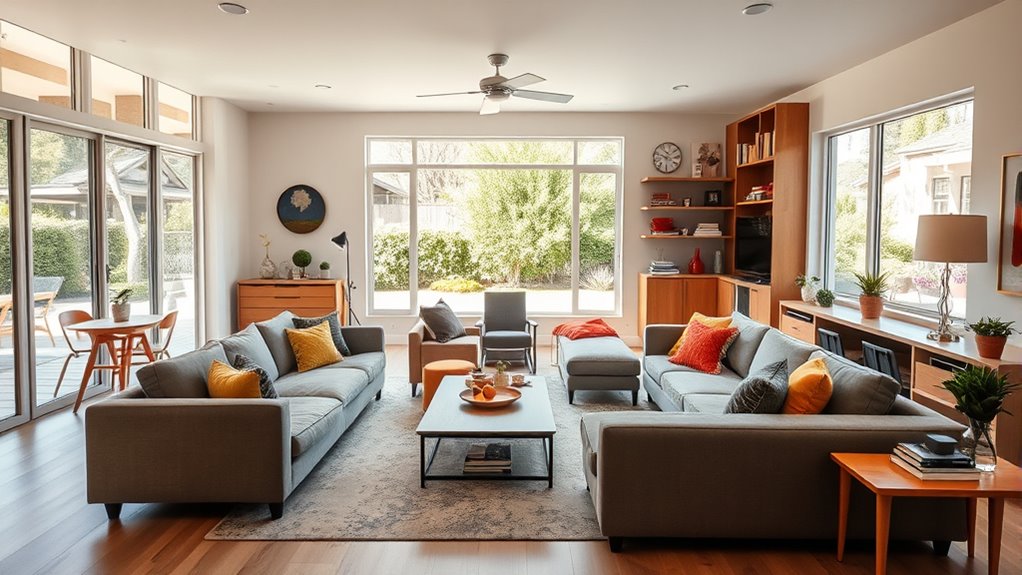
As your family grows and changes, customizing your home’s spaces becomes essential to keep up with evolving needs. You can personalize rooms by adding features like chalkboard walls or colorful rugs that reflect your children’s interests and achievements.
Incorporating flexible layouts allows you to adapt bedrooms and common areas as kids shift from toddlers to teenagers. Using adjustable furniture pieces and designing multi-purpose rooms ensures your spaces can evolve over time.
Creating dedicated areas for activities like play zones or homework corners helps meet your family’s unique needs. Thoughtful personalization deepens emotional connections to your home, making it a welcoming environment that adapts seamlessly to each family member’s journey.
Frequently Asked Questions
What Is the Average Cost to Design a House?
You’re probably wondering about the average cost to design a house. Typically, you’ll spend between $2,000 and $8,000 for basic plans. But if you want something custom with detailed features, it could go over $20,000.
Keep in mind, design fees usually make up about 5% to 15% of your total construction budget. Your costs depend on size, complexity, location, and whether you hire an architect or designer.
How to Design a Home for Aging in Place?
Think of your home as a sturdy tree, built to endure changing seasons. To design for aging in place, you include wider doorways, step-free entries, and lever handles, making navigation effortless.
Add safety features like grab bars and non-slip flooring.
Plan for future upgrades like stairlifts or main-floor bedrooms, ensuring your home adapts gracefully.
This thoughtful approach keeps you comfortable, independent, and rooted, regardless of how your needs evolve over time.
How to Design a Kid Friendly Home?
You want a kid-friendly home that’s safe, fun, and adaptable. Use durable, stain-resistant materials like quartz countertops and vinyl flooring to handle spills and messes.
Create flexible spaces such as open-concept areas and multi-purpose rooms that grow with your kids.
Add safety features like outlet covers and corner protectors.
Dedicate zones for play, with built-in storage and colorful rugs.
Plan bedrooms with adjustable furniture for evolving needs.
Can I Design My Own House and Build It?
You can absolutely design and build your own house—it’s like crafting a custom suit that fits you perfectly. Work with architects or custom builders who can help shape your vision into reality, ensuring everything meets code and structural standards.
Using design tools or software makes the process easier, but teaming up with professionals guarantees your dream home is practical, cost-effective, and ready to grow with you over time.
Conclusion
By designing a home that adapts as your family grows, you create a space that truly fits your life. Did you know that 78% of homeowners who plan for flexibility report higher satisfaction with their living environment? Embrace versatile layouts, smart storage, and outdoor spaces that evolve. Collaborate with experts to future-proof your home, ensuring it remains functional and personalized for years to come. Your adaptable home will grow with you—and make every moment more comfortable.
